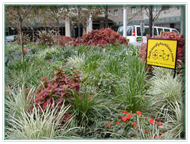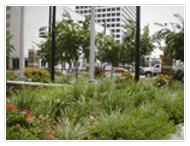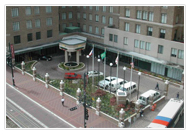green roofs in huston
Perlite in lightweight green roofs in Houston, Texas
Green Roof Technology
So-called “Green Roofs ” are being built more and more throughout the world, especially in Germany and increasingly in the United States.
And contrary to popular opinion or conventional wisdom, they don’t have to be complicated or expensive.
Jennifer Appel is a landscape architect in Houston, Texas who had to solve a problem: how to retrofit ” an intensive green roof on a1921 historical structure.” Needless to say , the job required “knowledge of structural loading, wet weight loading, drainage, soil media selection, plant selection, irrigation fertigation and long term maintenance, while creating the design of the client’s dream requests.”
After researching different possibilities on the internet and talking with representatives of The Schundler Company, Jennifer decided on a rather new and unique soil mix: Perlite and packing peanuts.
As Jennifer wrote in an email:
When I was researching different media sources I talked to someone at Schundler who said it would not be possible to grow trees in the mix. (FYI – it works better than soil.) Next time I have an opportunity to repeat the process, I will go more to a 50/50 and blend it during installation.
When we were installing this – the biggest problem was wind. So, we pulled (2) all nights, because the winds are almost null after dark.
Another factor to consider: the Perlite and peanuts have a tendency to float – but with about 2″ of shredded hardwood mulch – the media stays put. Do NOT use pine bark mulch – this will exacerbate the problem.
The mix is: 70% Perlite horticultural grade and 30% peanuts. The peanuts are at the bottom with the Perlite on top. The depth of the planters is 3’6 -(as a force protection barrier).
I use 1-2 minutes of water per day in the fall, winter, and spring. I use 2 minutes (2 times a day) in the summer (we are in Houston and it gets really, really hot here at mid day).
I have gone to the all organic program, feeding once a week. What we learned: All the one gallon plants exceeded 5 gallon size within 4 months. This is huge… it normally takes one whole year to get
11 of the crepe myrtle trees flowered for 11 months and 1 tree has flowered continuously and is setting new flowers right now. I have done some plant pull tests to see how well the root systems are forming on some of the plants. These plants have some of the largest and well formed root systems that I have ever seen. (I have been in the landscaping industry for over 10 years.) Hyphae, usually not visible, are extensive and the root masses are very strong. Even replacing the plants – they had no noticeable transplant shock.
I sent the same package to a hot house grower in Dallas. She had the same type of results indoors with Broccoli and all of her vegetables using the same mix and the same fertilizer.”

(With no fertilizer, coleus normally reaches 2 to 3 feet in height and width, and dies in the winter.)

After 4 Months
In another email, Jenny addressed some of the problems of weight and wind uplift:
The logical position is to make the green roofs planting area light and thin. (Geo mats)
If we remove weight as a constraint – based on super lightweight soil-less media, then plant selection based on wind would become the most critical factor.
So far, what I have noticed are a series of geo textile mats of various depths that provide for very little root mass.
In my landscaping experience, when the root zone is stunted (bonsai), the plants do not perform as well as they do when they have a large, well formed root system.
When you asked about wind loading – my answer is this: Most plants have a root zone between 6″-30″ below the soil line. If we can provide a planting area that is 30″ deep, then we can expect the regularly fertilized root systems of the plants to intermingle and create a “mat” within the soil-less media.
Once a root mass is established, then single plants will not have a > tendency to uproot with high winds. (At least that is one of the theories that I am successfully testing at the Humble Building.) One catch to this is that the plants must be spaced appropriately. When at full ‘mature’ size, plants do not overlap each other or the root systems will not form correctly due to a lack of space. (i.e.: if a plant grows 3′ around, do not put it on an 18″ center.) I could diatribe this for days.
Another issue is plant selection.
I believe that the geo mats do work. They work very well in their current applications. They would not work for my application.
I would really enjoy the opportunity to consult on another project of this scope to test additional theories about making green roofs mainstream in urban areas.
And if you would like to contact Jennifer Appel, or use her as a consultant, she can be contacted at: This email address is being protected from spambots. You need JavaScript enabled to view it. or visit Landscape Vitamins

After 7 Months





